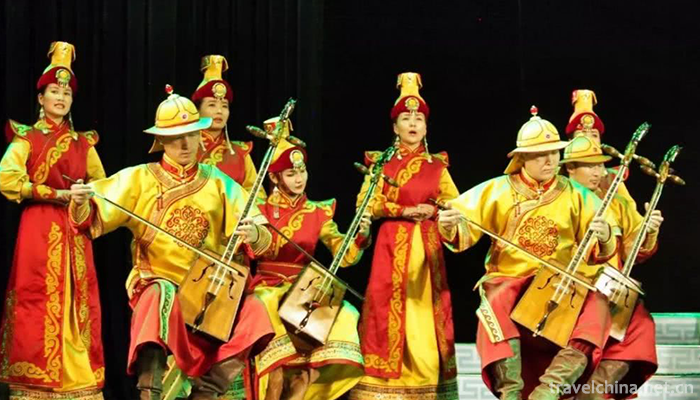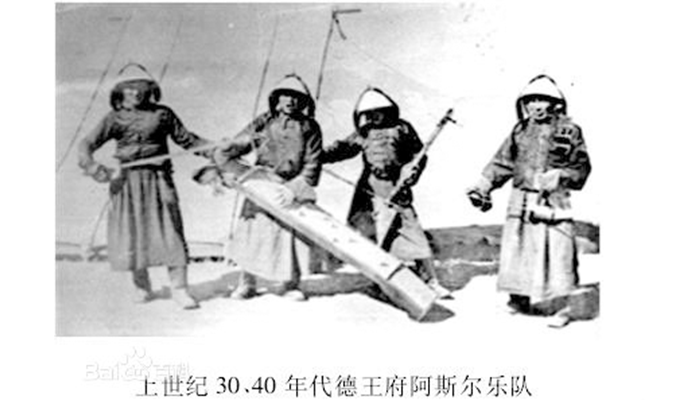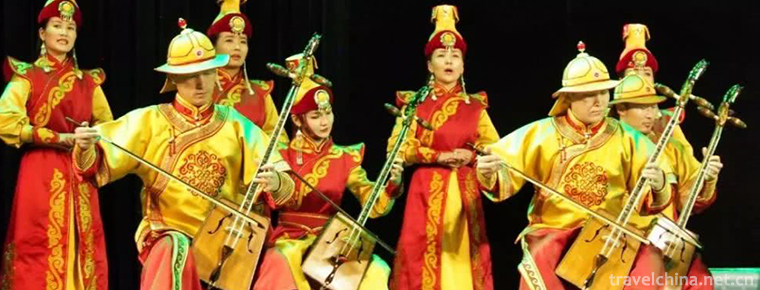Asil Lysi
Asil Lysi
"Asr" is the abbreviation of "Asru Winder" in Mongolian, and its translation is of great significance. Asr is a kind of Mongolian court music, which has a unique national style and is widely spread in the original Chaharmong area. Aser is a popular Mongolian court music in Yuan Dynasty, which is widely inherited and has become an excellent Mongolian national culture.
"Aser" music absorbs the elements of Han and Manchu national music at the same time. It has a wide range of compatibility and unique nationality, and has important artistic value and research value.
On December 03, 2014, Asr declared by the Yellow Banner Inserted in Inner Mongolia Autonomous Region was listed in the fourth batch of national intangible cultural heritage list with the approval of the State Council.
historical origin
Asr is the general name of an ancient music spread in the Chahar grassland. It originally belonged to the Royal noble music and was the popular Mongolian court music in the Yuan Dynasty. Among them, "Aduqing Asr" ranks first among the eight Asr in Chahar, which has the characteristics of long inheritance history, wide dissemination scope and complete preservation. According to textual research, 60% of the other Asr music spread in Aduqing Asr and Chahar grassland is concentrated in the Yellow flag, which reflects the unique folk customs of the ancient Chaharmong people and is often used in large-scale celebrations.
In the process of dissemination and inheritance, Aser mainly takes official and folk ways. The official performance of the "Music Band" in Wang Gongfu residence is mainly inherited from generation to generation by musicians, while the folk inheritance is mainly inherited by teachers and apprentices. Wangfu music and folk music depend on each other, penetrate each other, and transform each other under certain conditions. As a form of banquet music, Aser was influenced by folk music, and also favored by Wangfu Band musicians and even literati and refined musicians. In addition, most of the musicians of the Wangfu Music Band come from highly skilled performers and artists. In the practice of playing Asr, they also participated in the processing and enrichment of Asr's creative activities, so that in the long process of dissemination and inheritance, they have the dual characteristics of Wang Fu music and folk music.
Since the early Qing Dynasty, with the establishment of the alliance flag system in Chahar area, Chahar flags often hold large-scale banquets, Nadam and other activities. Various folk customs and activities and Buddhist affairs of temples and monks have never been interrupted. As an important art form in the region, Aser is closely related to these activities and plays an important role in the dissemination of culture and art in the region. In other words, a wide range of social and folk matters in Chahar area need Asr music, and Asr music has also been widely disseminated through social and folk matters, and has been popularized among the people, thus forming a benign interactive relationship.
After the founding of New China, the music culture of all ethnic groups in Inner Mongolia has entered a new period of development. In the late 1940s and early 1950s, the chairman of the autonomous region, Ulanfu, encouraged the Inner Mongolia Cultural and Works Group to absorb instrumental talents from the folk. At that time, horsehead piano master Salaxi, Sihu master Sun Liang, as well as Asr master Babadolji, Salingrad and other people were transferred to the Inner Mongolia Literature and Works Group, making Mongolian traditional instruments and music on the professional literary and artistic stage. In 1955, Inner Mongolia Song and Dance Troupe came to Beijing to perform. The opening ceremony was "Asr" song and dance and music. It took the lead in putting this ancient banquet on the stage and won the praise of the capital audience. In the same year, the literary and artistic team composed of the backbone of literary and artistic groups in Inner Mongolia rehearsed the large-scale chorus "Inner Mongolia Good", whose theme tone was taken from the instrumental music "Aduqin Asr", which was praised by experts, and the Central Radio specially sent people to record the program.
artistic characteristics
"Aser" is a general name of Mongolian ancient instrumental ensemble, is the main representative of Xilinguole grassland silk and bamboo music, belongs to pure instrumental banquet music. It is spread in the former Chahar area in the south of Xilinguole League, Inner Mongolia. Usually by the Mongolian traditional bow string instruments, plucked instruments and wind instruments, the main instruments used are: Iqili - Matouqin, Hur - Sihu, Yatoga - Mongolian Zheng, Xiangji - Sanxian, Linbi - flute. It can also be seen in solos, humming, whistles and other different forms of performance.
There are two meanings of Asr in Mongolian. First, in Mongolian, there are honorifics such as "Azuli Tenggery", "Azuru Ih", "Asr Ih Wendur". Related to this, there are also several kinds of "Aslin Wendur" in ancient court music, which all have the meaning of "sublime" and "great". Second, people call the houses inhabited by ancient Mongolian Khans, nobles and living Buddhas "Ao Rideng Ha Rixi" (palace) or "Asr Takta" (pavilion). Therefore, the first part of the music played in their palace is called "Aslin Windu", "Asl", and the music is called "Asl Dena". According to the relevant documents, "Asr" can be traced back to the period of Genghis Khan's Western Expedition. The early themes mainly include the praise of Genghis Khan and Mongolian iron riding. The repertoire includes "Dahan Asr" and "Splendid Asr".
"Aser" is the Mongolian court music prevailing in the Yuan Dynasty, similar to the western symphony, can be said to be the Mongolian symphony, is the representative of Mongolian mainstream orthodox culture. During the performance, the performers were dressed in Mongolian costumes. The musical instruments were mainly horse-headed qin, four-hu, dulcimer, flute and so on.
Representative works
"Dahan Asr" and "Splendid Asr"
Zhenglan Banner has established the Asr Original Ecological Art Association, and the Banner Culture Museum has collected and sorted out 10 Chahar Palace Music Scores, including Chahar Palace Banquet Song, Shuangba Yin, Da'an Music, Four Seasons of Peace, Qing Dynasty, Yuanyang Mansion, Ping'an Zhou, Pastoral Horse Song, Three Gifts, Xingshan Jide, Bayin Asr and Zheng'an'an'an'an. White Banner Asr, Ming'an Asr, Taipu Temple Asr, Zhenghuang Banner Asr are five banner Asr music scores; Asr of Herding Horses, Asr of Suluk Pasture, Asr of Zhenghuang Pasture; Asr of Shepherd; Asr of Sulagai Asr, Asr of Band, Asr of Chagan Asr are three variations of Asr.
Inheritance significance
With the passage of time, by the end of the last century, the once brilliant "Asr" music was in an awkward situation of survival and was on the verge of being lost. Some of the songs were no longer able to play, and many young Mongolian people did not know what "Asr" meant. In order to save this ancient Mongolian instrumental music, nearly 30 pieces of court music were compiled by "Asr Music Town", involving more than 20 sets of court costumes of "Asr".
"Aser" music has been successfully declared as the intangible cultural heritage project of the autonomous region, and has been named "Aser Music Town of Mongolian People in China" by the Chinese Association of Folk Literature and Art Artists. It plays a positive role in protecting and inheriting the excellent national culture and promoting the construction of national culture.



-
1.Pork ribs Noodles
Pork ribs Noodles are a traditional pasta, especially in Cantonese cuisine
Time 2018-10-12 -
2.Malenqi Peak Forest Tourist Area
Located at the junction of Tongling, Nanling and Fanchang counties on the South Bank of the Yangtze River, Maren Qifeng scenic spot is located in the middle of the southern Anhui tourism belt
Time 2019-02-06 -
3.Mogao Grottoes
Mogao Grottoes, commonly known as Thousand Buddha Caves, are located in Dunhuang at the western end of Hexi Corridor. It was built in the pre-Qin period of the Sixteen Kingdoms.
Time 2019-02-07 -
4.Tianlong Tunpu
Tianlong Tunpu Town is located in Pingba District, Anshun City, western Guizhou Province. Deep in the mountains of karst landform, Tiantai Mountain and Longan Mountain are two mountains
Time 2019-02-21 -
5.Xigaosong Scenic Spot
Xiqiaosong Scenic Area is located at the foot of Tianjing Mountain, 13 kilometers west of Chengxian County, in the middle of Yuqiaoxia, a national AAAA-level tourist attraction
Time 2019-02-25 -
6.The Making Skills of Hui Ink
Hui ink production technology, Jixi County, Shexian County, Huangshan Tunxi District, Anhui Province, local traditional handicraft, one of the national intangible cultural heritage.
Time 2019-05-04 -
7.Old soup essence formula
The formulation of Royal Food Old Tangjing includes the formulation and production technology of Old Tangjing, which is a valuable cultural treasure in the history of condiment development in China. T
Time 2019-05-11 -
8.Nanyin Rap
Nanyin rap is a form of rap sung in Guangzhou dialect. It is also a common melody in Cantonese opera and Cantonese opera. It is said that Nanyin rap was developed on the basis of wooden fish and drago
Time 2019-06-07 -
9.She Costume
She nationality's men and women's clothing is basically the same as that of the local Han people. However, the She ethnic costumes in Fujian and Zhejiang provinces with relatively concentrated populat
Time 2019-06-14 -
10.Guan Yu
Guan Yu(? - 220 years), the word is long, then changed word cloud length. Hedong County Jie county (today) Shanxi Yuncheng People are called "beauty beard Gong". Early follow Liu Bei In the
Time 2019-09-07 -
11.Liushi Manorial Museum
Dayi Liushi manoral museum is located at No.15, Jingui street, Anren Town, Dayi County, Chengdu City, Sichuan Province. It is one of the important historical sites and representative buildings in modern China.
Time 2020-11-05 -
12.Chengdu Metro Line 1
Chengdu Metro Line 1 is the first metro line to be completed and put into operation in Chengdu, Sichuan Province, China. It is the first metro line opened in Western China. The first phase of the project was opened on September 27, 2010, The phase II project (Century City station to Guangdu station)
Time 2020-11-28